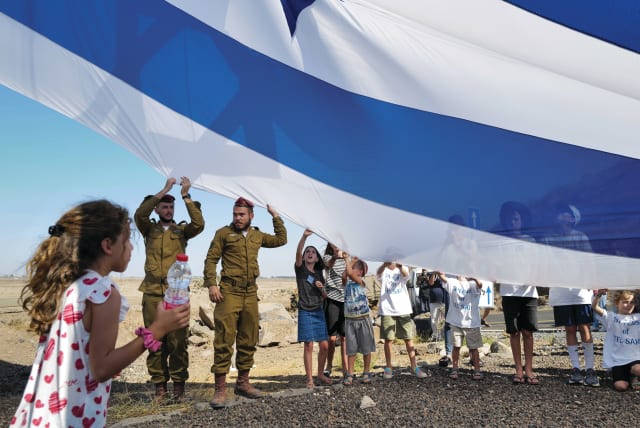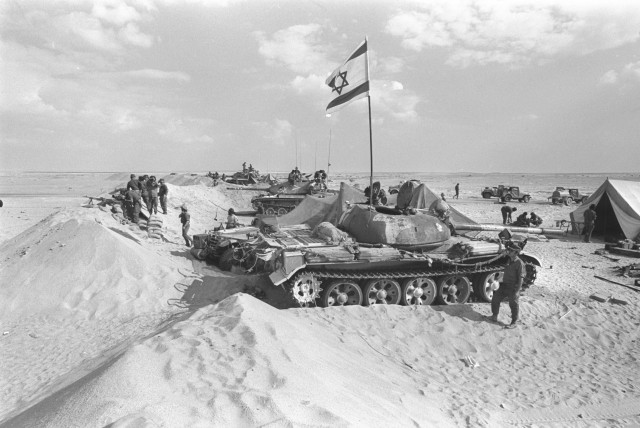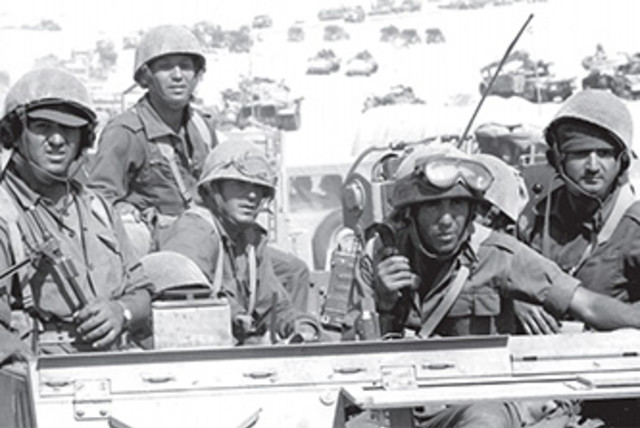The Yom Kippur War served as debut of religious units of soldiers - comment

It is even more difficult to distill the religious meaning of this war.
The Yom Kippur War merged tragedy and triumph, leaving us in a confusing state of sorrow mixed with joy. Initially stunned by a surprise attack, we courageously turned the tide, achieving daring victories on two fronts. Previous wars were easier to quantify and comprehend. The Yom Kippur War was more puzzling and still defies simple classification.
It is even more difficult to distill the religious meaning of this war.
The War of 1948 established the first sovereign Jewish state in 1,900 years. The unintended consequences of the Six Day War returned us to our biblical homeland and reunified Jerusalem. The hand of God was readily apparent in each conflict.
Identifying the religious meaning of the Yom Kippur War is more challenging. This traumatic war didn’t reshape our borders, and it inflicted staggering casualties. The sadness of this war baffles our attempts to draw coherent religious lessons.
However, religious people view all major events through a lens of faith – and this war was no different. Our national restoration is part of a larger divine project, and a war of this magnitude must be framed within a larger historical trajectory. Alongside the sadness and mourning, we search for religious meaning. Here are a few religious consequences of this confusing war.
Religious consequences of the confusing war
Our holiest day: Our enemies attempted to exploit this day to their advantage. Too occupied with prayer and penitence, we could not be expected to quickly rally to the battlefield. The very premise that our holiest day of the year, gifted to us by God, could be weaponized against our people was unthinkable in heaven. Despite our being caught off guard, God would not allow us to be defeated by enemies wielding His gift of Yom Kippur against us.
The Yom Kippur timing further underscored that our struggle with the Arab world was never a localized geopolitical skirmish but part of a broader historical struggle. We were chosen by God to reflect Him and His moral spirit and were invited to His land. Our haters have always opposed our chosen status, and our current enemies stand in protest to our presence in the land of God. The Yom Kippur war signaled that the clashes in the Suez Canal or the Golan Heights were, ultimately, a battle over our people’s return to Jerusalem. The Yom Kippur timing merely reminded us that it always was, and always will be, about something larger.
Finally, the timing ensured that Yom Kippur would forever remain sacred for the entire nation. The suffering and heroism left an indelible impression on the Israeli population, converting this period into a national experience of introspection, collective faith, and spiritual reflection. The solemn memory of the war carved out a “space” for national commemoration, even among those who aren’t classically religious. Despite our divisions, the overwhelming majority of Israelis commemorate Yom Kippur, and for many the war is a powerful spiritual anchor to Yom Kippur. The war entrenched the Yom Kippur experience for all Israelis.
An international conflict: Unlike the two previous wars, this war was deeply impacted by broader international dynamics. New weapons provided by the Soviet Union, such as Sagger anti-tank missiles, surprised our forces and caused heavy casualties. Regiments of soldiers from at least five Arab countries joined the war.
While the Soviet Union provided arms shipments to the Arab armies, the US conducted massive airlifts of munitions to Israel. Though we had effectively encircled the entire Egyptian third army, we backed down because of the tangible threat of the Soviet Union entering the conflict. The Yom Kippur War was a global chess match extending far beyond the sands of the Sinai desert.
During the war, the oil embargo was deployed as a weapon for punishing countries that had been supportive of Israel. The entire world realized that Arab oil fields were not a dependable source of energy. Ironically, the war awakened the world to begin its long search for alternate forms of energy.
Our return to Israel isn’t a sideshow but impacts the broader trajectory of human history. In 1973, the internationalization of the Arab-Israeli conflict reinforced our belief that this struggle over our land is a central element of a larger historical calculus.
STABLE BORDERS: The Yom Kippur War was the last war fought on Israeli soil. Although we still live with the threat of terrorism and still face constant missile barrages, our homeland hasn’t suffered actual warfare since 1973. The Torah states that if we adhere to divine will, “no sword shall pass through our land.” Over the past 50 years, in the absence of war, our land and its infrastructure have flourished. \
Furthermore, the war of 1973 was the prelude to our gradual détente with most of the Arab world. The war demonstrated that even when disadvantaged by a surprise attack, we could not be dislodged from Israel. Our neighbors were left with only one credible option – to normalize relations and accept us into this region. Over the past 50 years, we have gradually signed peace treaties with much of the Arab world.
The Yom Kippur War both stabilized our borders and consolidated our hard-earned diplomatic acceptance. This international acceptance, still under construction, is an essential part of the divine project to advance history. The Yom Kippur war was instrumental toward that goal.
Courage and heroism: We have always fought courageously to protect our homeland. The nightmare of the Holocaust and the horror of Jewish persecution taught us about the necessity of a Jewish homeland. As we have no place to run, we stubbornly defend our homeland. Our tenacity always provided us with a military advantage as Arab armies were an invading force, but we were defending our homeland. Without courage and heroism, our state could not be born nor defended.
However, the bravery of 1973 far surpassed mere courage. The first wave of soldiers, who battled during the initial dire days of the war, knew that they faced incalculable odds and stood a good chance of never returning. Small groups of soldiers doggedly held off overwhelming columns of tanks and infantry, allowing our reservists a chance to regroup and launch a successful counteroffensive. They fought knowing that their death was likely. This war returned us to the battles of Hanukkah – many in the hands of few. God planted patriotism, self-sacrifice, and fearless dedication to our people within every single Jewish heart. Religious Jews must learn to recognize this divine spirit, even when it isn’t clothed in classic religious garments.
An army for religious soldiers: Religious Israelis have always defended our homeland; but during this war, for the first time they served in distinctly religious army units. In the aftermath of the Six Day War, religious frameworks combining Torah study and army service, such as hesder, were popularized, and the Yom Kippur War showcased the dedication and patriotism of newly minted soldier-scholars. Tank units, which bore the heavy brunt of the fierce battles, were composed of significant numbers of religious soldiers – many of whom lost their lives.
Since this war, serving in the IDF has become incorporated into the lives of many religious Israelis as an essential part of their religious experience and moral duty. Religious soldiers typically demonstrate high levels of motivation for what they see as a religious calling. The Yom Kippur War served as the debut of religious units of soldiers protecting our homeland.
Along with the tears and sorrow, these are some of the religious implications of a very complex and often confusing war.
The writer is a rabbi at Yeshivat Har Etzion/Gush, a hesder yeshiva. He has smicha and a BA in computer science from Yeshiva University, as well as a master’s degree in English literature from the City University of New York.
Jerusalem Post Store
`; document.getElementById("linkPremium").innerHTML = cont; var divWithLink = document.getElementById("premium-link"); if (divWithLink !== null && divWithLink !== 'undefined') { divWithLink.style.border = "solid 1px #cb0f3e"; divWithLink.style.textAlign = "center"; divWithLink.style.marginBottom = "15px"; divWithLink.style.marginTop = "15px"; divWithLink.style.width = "100%"; divWithLink.style.backgroundColor = "#122952"; divWithLink.style.color = "#ffffff"; divWithLink.style.lineHeight = "1.5"; } } (function (v, i) { });


